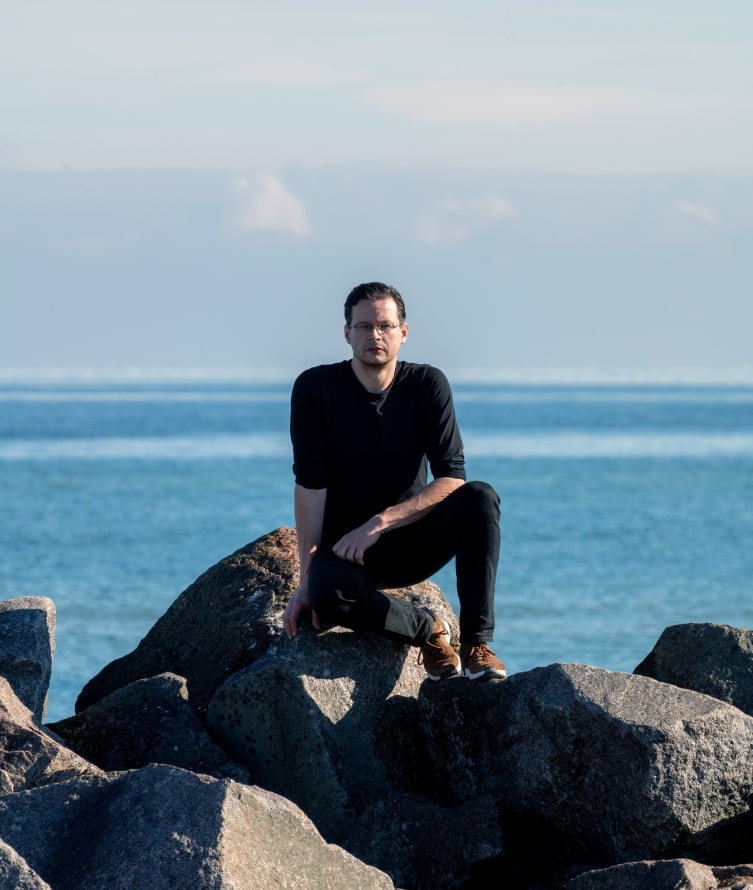PROLOGUE | PERSONAL
René, imagine the pandemic would not dominate our lives at the moment and we could meet in your home or in your studio. Where do we speak together, where do we meet? We meet in Kiel, on the western edge of the town, in my house. Surrounded by family houses and greenery. Behind the house is a large garden, behind that a small wood. If you look out of the window, you only see green, also because there is a giant sequoia tree in the garden. If you see the house and don’t enter the studio or the paintings storage room, you don’t suspect that an artist lives and works in the house. A journalist once wrote about our flat as “wonderfully unpretentious”. He meant “boring”, of course. Maybe we are sitting at your favorite place? We sit in the studio, my workplace. As I am working most of the time and no one forces me to do so, one could call it my favourite place, so to speak.
René Schoemakers, Portrait, Baltic Sea near Kiel, 2021
Photo: © Tom Fechtner
Where do you come from, where were you born when? I was born in 1972 in Kleve on the Lower Rhine. I lived there until 1992 and also had my first exhibitions there starting in 1987. Kleve is perhaps better known in the art world as the place where Joseph Beuys grew up. How and where do you currently live and work? I have lived in Kiel since 1992, first with my wife, with whom I have been together for 34 years, and then with more and more children, in the end five. My studio is in the basement of the house, after my time at art school I always had my studio in the house where I also lived. Which stations and people have shaped you? As the person involved, it is probably not possible to give completely objective information about this, especially since such processes primarily take place behind the back of the passive protagonist. Presumably – as far as I can reconstruct it myself – my origins shaped me first. I am a Catholic working-class child from the countryside. That is probably the reason why the art world, the art business as a whole, are and remain habitually strange to me. Art is a bourgeois institution, and I am a peasant.Furthermore, my relationship with my wife must have had an influence on me, because when you live together for 34 years and have done a lot of things together regarding my art, then that must also be formative.
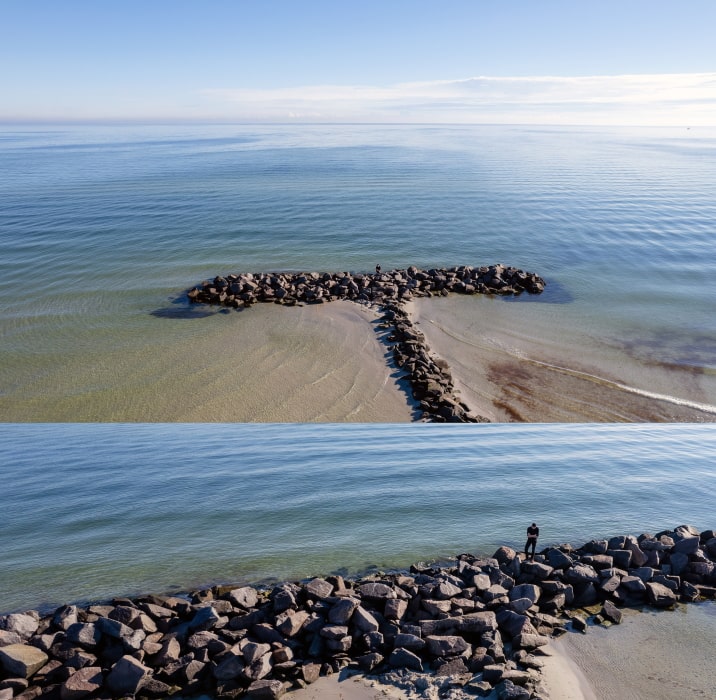
Which writers do you currently find exciting and which books are on your bookshelf? My personal bookshelf currently contains around 2200 books from the fields of philosophy, literature, and art. The interests change quickly, depending on the working context. What is exciting at the moment is determined by the current work.My most recent intensive literary reading experience was George Saunders. Interestingly, I read him completely “backwards: Lincoln in the Bardo, Tenth of December, I Can Speak, Pastoralia, CivilWarLand in Bad Decline. I am a completeness junkie.31 volumes of Thomas Mann on the shelf… The complete works are always the framework of structural knowledge for me. You can’t understand an author, musician or painter through a few works. So I always have to have everything if the worst comes to the worst. Which books have influenced or shaped you Kant’s critical writings, Hegel, Horkheimer/Adorno, Habermas, Wittgenstein, Martha Nussbaum, Arthur Danto, Nelson Goodman, Gilbert Ryle, John Langshaw Austin, Donald Davidson, Robert Brandom etc. Literary: Thomas Mann – Joseph and His Brothers, Thomas Pynchon – Against the Day, David Foster Wallace – Infinite Jest, William Gaddis – The Recognitions, George Saunders – I Can Speak, William Saroyan – Human Comedy.

What are you currently reading and where do you keep the book? Ronald Dworkin – Justice for Hedgehogs (there are no hedgehogs in it). But the study with the bookshelves is next to the studio. Everything must always be at hand. What music do you listen to and when? I listen to music while painting or writing. Mostly from a spectrum that is usually described as “progressive”. Classic stuff from the 70s, King Crimson, Yes, Gentle Giant, Genesis, Rush, Camel etc.. Then also newer stuff like Between The Buried And Me, Tool. Preferably everything that doesn’t approach the listener with the sticky promise of authenticity. Punk is a musical Sachertorte. Exception: Sleaford Mods. As a proletarian, I’m allowed to listen to that. If you would cook something for us, what would it be? Edible in any case. Or let’s say there would be a 95% chance. What do you like to eat most? Food. What do you think about breakfast? How do I feel about breathing? — “Dad, have you eaten mud yet?” (Objectively, from the perspective of informed adults, “mud” is just low-fat cottage cheese with a mixture of grains, seeds and nuts). I eat mud. And I appreciate mud very much.
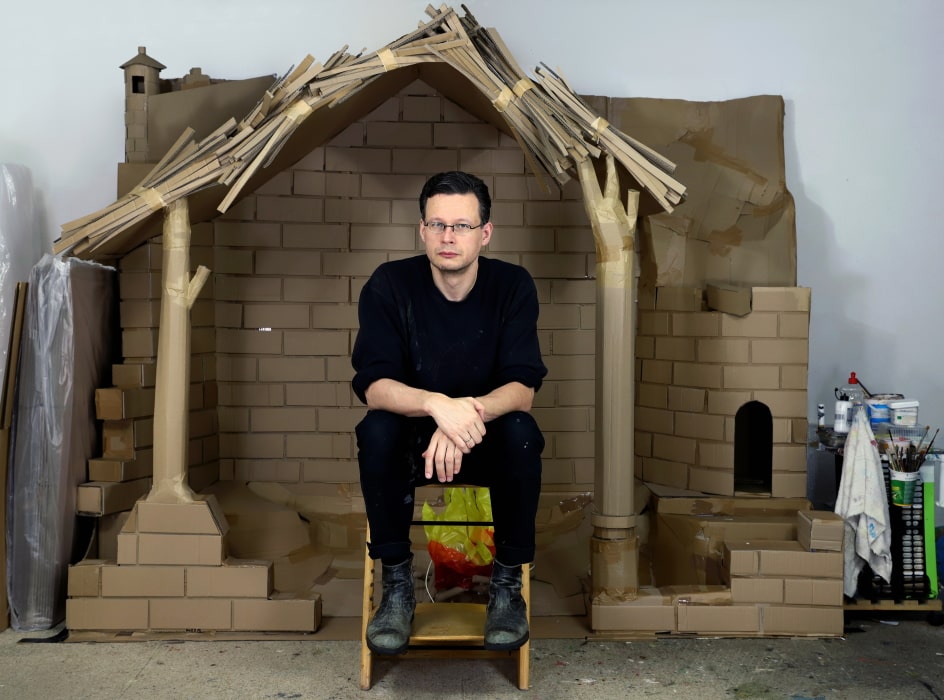
What kind of sport or counterbalance to your work do you practice? The counterbalance to my work is sleep. Sport: yes. Do you have special passions, hobbies, for which you are burning, and if so, which ones? Rather not. When I was 14 or 15, I had to decide what was most important to me: writing, painting or music. It was painting then. When I was young, I played in a band with friends for a while. Today I still have my electric guitar in my studio, and I play it occasionally when painting doesn’t get going. But otherwise, I only know two states of being: working or sleeping.
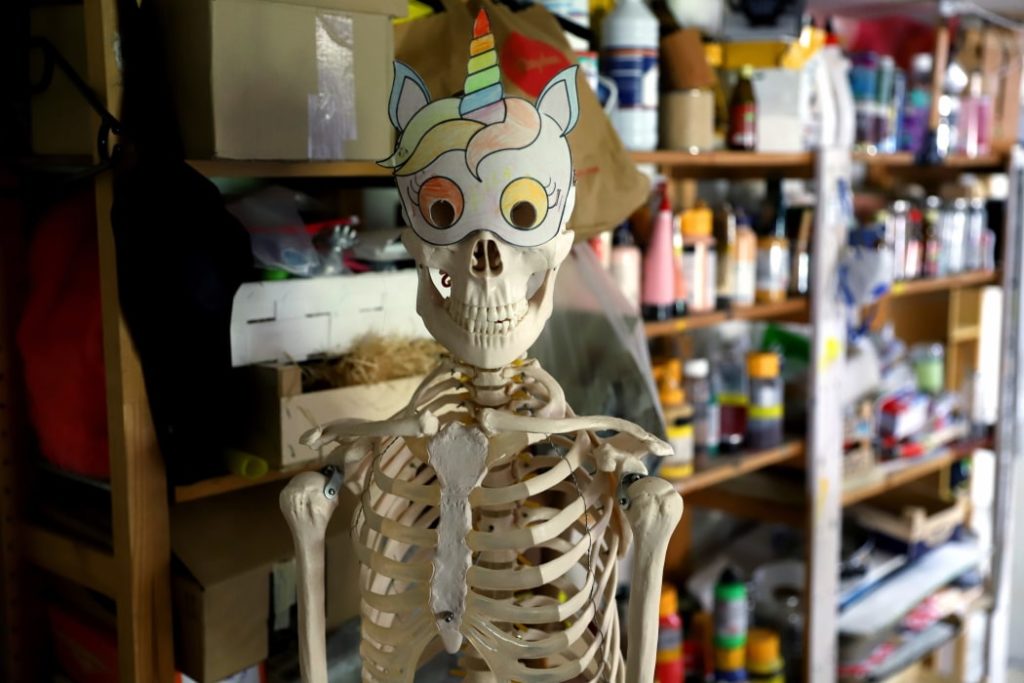
Foto: © R. Schoemakers
What personality trait defines you? Verstand. Manche Leute sagen auch, ein böser Humor. Mag sein, jedenfalls schließt das eine das andere nicht notwendig aus.
INTERVIEW | ARTIST + POSITION
To begin, please tell us your artistic vita in a few sentences.
Initially I started in several fields, philosophy, painting, literature, music. For some time, they were all on an equal level. But when I was 14, painting became the focus, and from then on, I basically painted every day. After I had met my later wife, I also started exhibiting, at about 16. When I was 18, I took part in a museum exhibition for the first time.
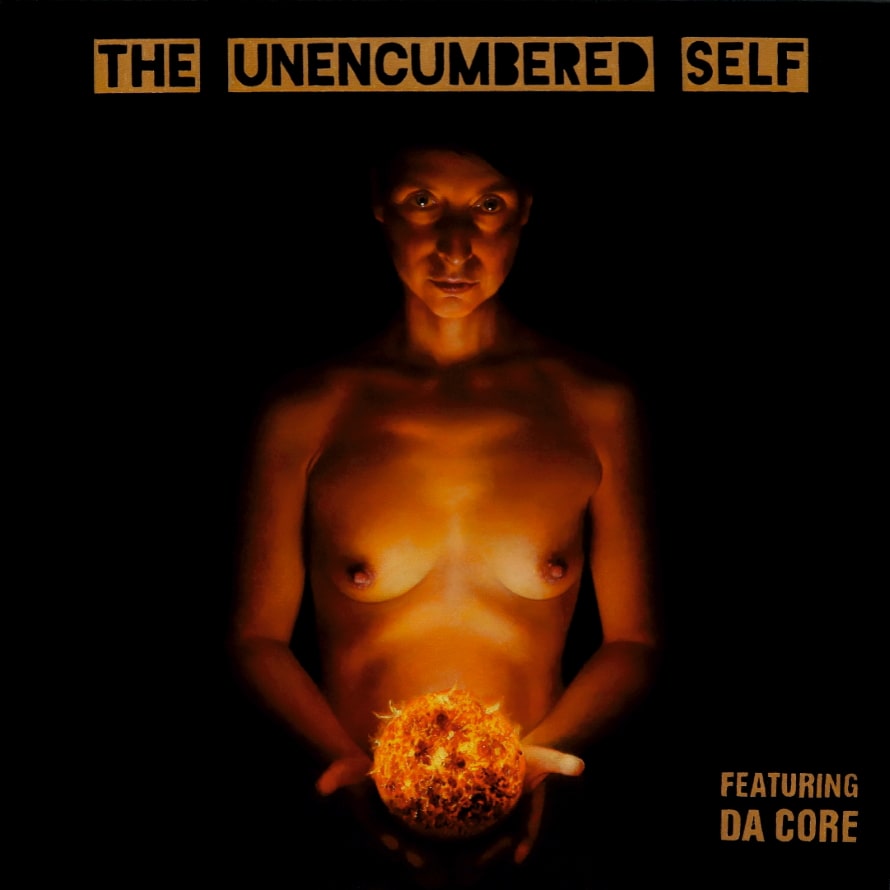
When I was 19, there was the first “scandal”, which went through the press in the city, and I was even phoned about it while I was doing my civilian service. From then on it was clear to me that art was destined to be my future.

. I did my portfolio for the admission test and after the basic semester I went to Peter Nagel’s painting class, the “class for figurative painting”. Overall, the studies were quite traditional compared to other art schools or painting classes; in addition to free work, for example, painterly nature study or drawing nudes and figures from models was obligatory, as was the competent mixing of egg tempera. Sounds unsexy, but I still benefit from having my hand and eye trained like that, I think.

At the end of my studies, I had my first solo exhibitions in museums in Schleswig-Holstein, and after graduation I had my first gallery cooperation in Hamburg. So it was always one thing after the other. Although I always noticed that my work was often suspicious to the people who run the art scene. Since the beginning in Kleve, I have done everything on my own: the art, the documentation, the communication. That’s why I have no real networks, which has led me to do more solo exhibitions than group exhibitions. But being marginal is not a flaw in itself.
Briefly explain your current project / the upcoming exhibition.
At the moment I am busy preparing my next exhibition at the Museum of Art and Cultural History in Dortmund. The exhibition is very extensive with about 160 canvases on about 1000 square meters of exhibition space.
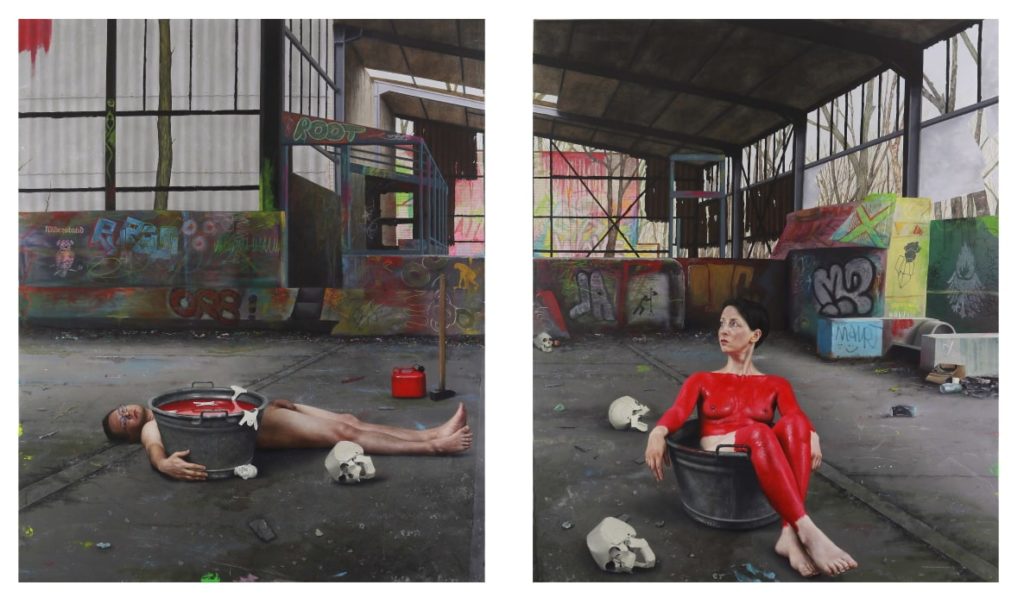
Besides the usual preparatory work, there is a lot more to do, as the exhibition will be extended into the city space with about 20 graphic motifs that will be displayed as posters in various places in the city, as well as in a long window front of the museum. Something like this always eats up a lot of time in planning and implementation. On the other hand, from August to January 2022, the main series of works from the last six or seven years can be seen there in context. A quarter of the works have been borrowed from private collections or museum collections, which always means some additional effort.
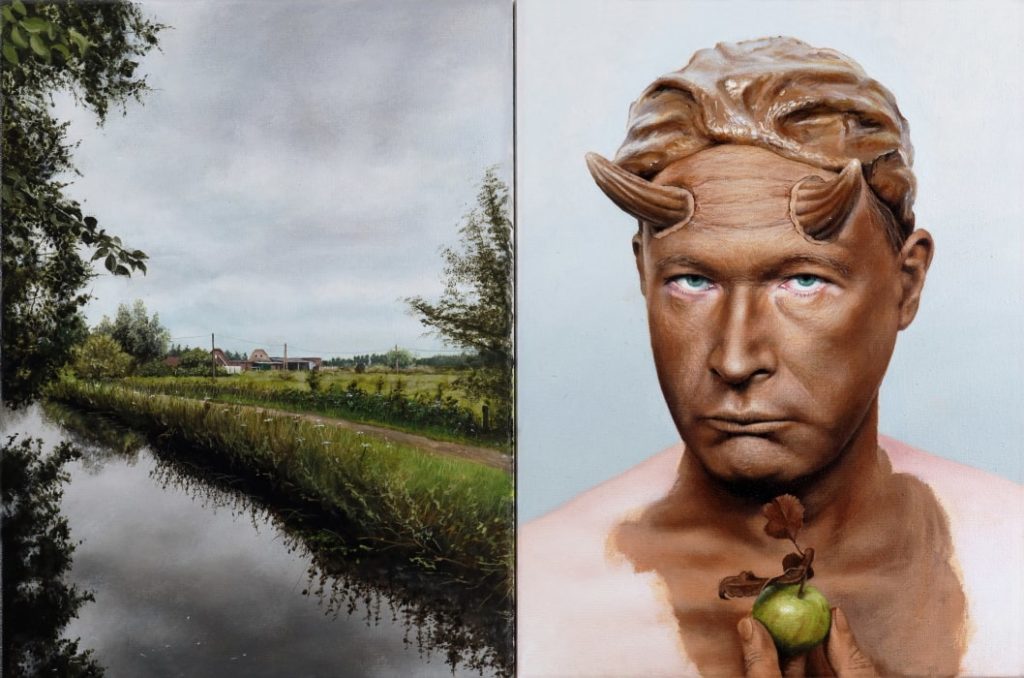
What are you currently most concerned about; what is on your mind?
Philosophers always think about everything, that is their profession. Specifically: whether the rampant tribalist-separatist nonsense can become so exuberant that in the end the idea of universalist humanism lies completely in ruins. Which, as a Kantian, would annoy the hell out of me. Stupidity sucks.

How did you come to art? Why art?
After Adam and Eve ate from the tree of knowledge of good and evil despite the prohibition, their primary recognition is that there is something to recognize. That what was only “there” until then is something they now have to identify. The world becomes an object and must therefore be recognized and understood. One could also put it with Heidegger that until then the Garden of Eden with everything in it was “ready-to-hand” to Eve and Adam, now all kinds of things are “present-at-hand”. Not least also Eve and Adam for each other. Logically, then, it is said that after the expulsion they “knew” each other.
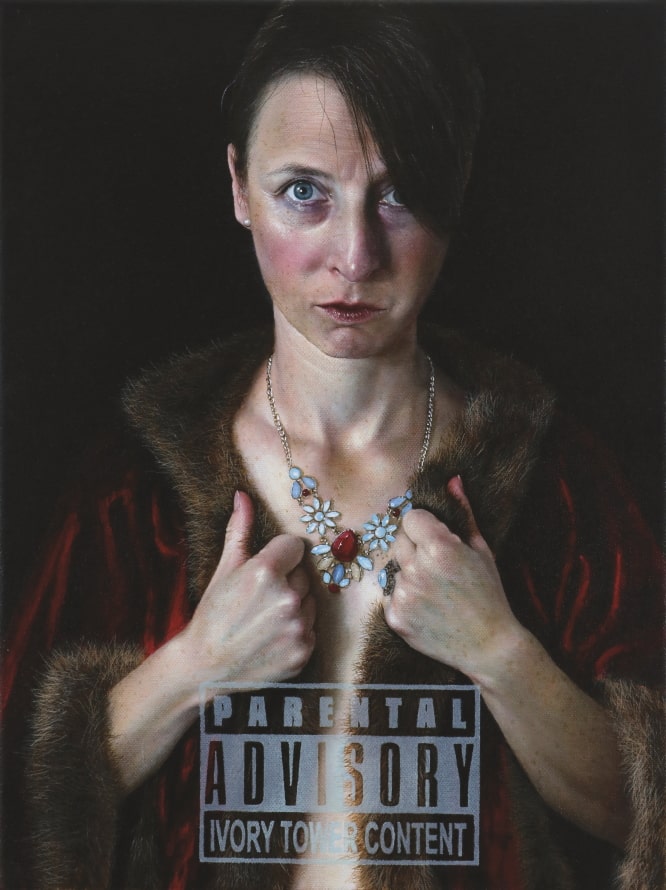
2017, Acryl/Leinwand, 40 x 30 cm
Before the Fall they did not even know that they were naked. And so, the Fall gave rise not only to eroticism but also to art, as a tense effort to “know” the world, which is always an active doing and shaping, can’t be a passive registering of what is. Consequently, in Goodman’s sense, art is a “way of worldmaking”, every work a work about (“aboutness” in Danto’s sense) a world that is recognized and produced in the work.
If, as a young person, one perceives oneself in a distanced relationship to the world, one can only become an artist to work through the aforementioned tension on the one hand, but paradoxically also to renew it again and again. As a scientist, one would usually state as an ideal that one wants to understand the world. As an artist, one begins with the realization that one brings it forth first and foremost.
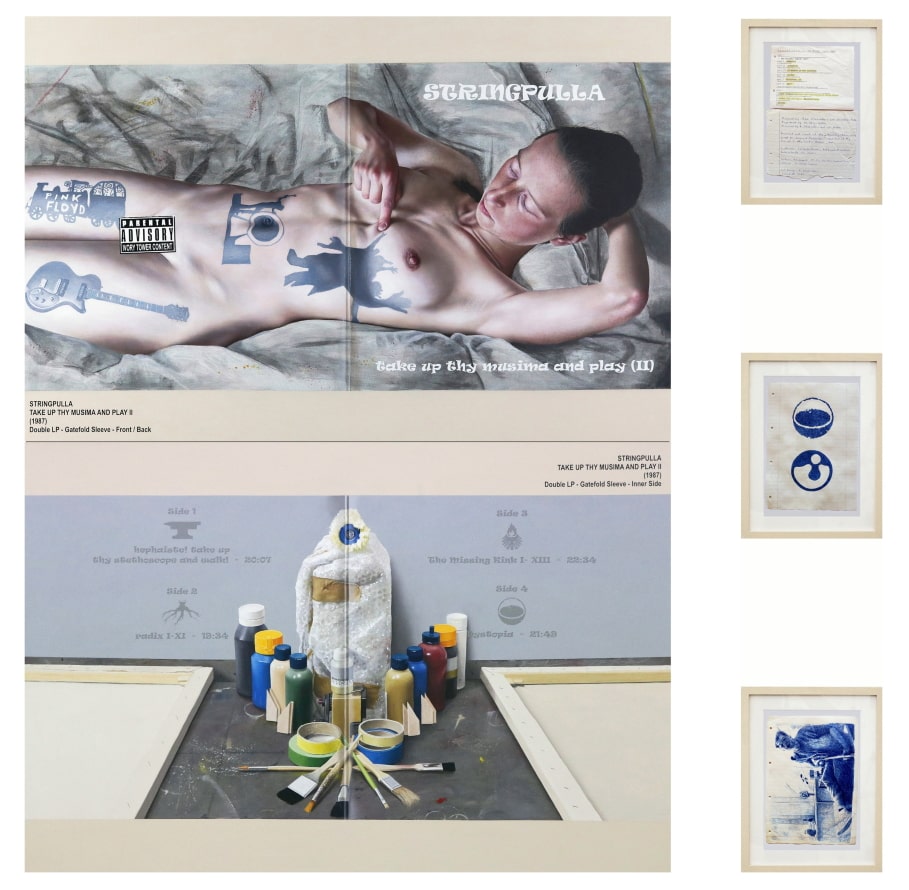
2016, Acryl/Leinwand, Kugelschreiber auf Papier, ca. 200 x 200 cm
What makes you happy at this moment?
To exist. Family. Wind in trees. Waves. (By the way: the happiest people in Germany live in Schleswig-Holstein. It must be the wind, my thesis).
What is currently scaring you?
Fear is not constructive. We have parted on mutual agreement.
Do you believe that art has a social responsibility? And what do you think it can do?
In a society based on the division of labour, art has above all the task of preserving what is its differentia specifica. Without wanting to argue essentialistically, one can nevertheless say that autonomy in the sense of self-legislation and not being instrumentalized is the essential characteristic of art in the modern sense. So if art wants to be heard as a voice in social discourse, it can only do so if it completely disregards the fact that it wants to be heard there. This is the paradox of art’s autonomy; only if it insists on being free of purpose and being completely irresponsible it will take responsibility and fulfil a social purpose.

Segismundo (forms&instances)
2014, Acrylic/Canvas, Foil, total approx. 70 x 210 cm
cubus-m, Berlin, 2015
Art is not a marketing department, not even for a good cause. Galleries, museums, art institutions have the task of being a safe space. For art and artists, for completely purposeless and irresponsible autonomy.
Only in that way art can have an effect. It is then entitled to disturb and agitate. And no artist complains about that, sensibly enough. Those who find my work obnoxious are welcome to do so. If you don’t want to show me, don’t show me, if you don’t want to see my work, go somewhere else.
I only have the possibility of creating a version of a world in the artefact and making it available for contemplation. Then you can see to what that leads. Sometimes I have my own view of this, sometimes none. It is not the artist’s task to consider this.

Die Tathandlung
2017, Acrylic/Canvas, 100 x 130 cm
What makes your art special? What is it about – what are the central themes of your work?
Read the answer of René Schoemakers to the question about his work further in THE DEED | DAS WERK.
How do you protect yourself from too much inspiration these days?
a) I live in Kiel. b) I sleep. c) I increase the complexity of my work to reduce the complexity of the inspirations (bad for the viewer, good for me). Can there be “too much inspiration” for an artist? Artists are brutally selective in their perception. If they claim to be particularly “open”, they have no idea of what they are doing. Then they are indeed defenseless.
How much in your works is planned in advance – how much is created intuitively?
If you work artistically, this opposition is actually suspended. Lyotard describes this quite well in “Rules and Paradoxes”. The rules of a work arise with the work itself. The artist does not know them beforehand but can reconstruct them afterwards – if he wants to. Others can do that too. In this respect, the question of what “the artist thought” is more or less irrelevant. For it is not the artist who hangs on the wall in the gallery or museum, but his work. And it is a matter of reconstructing the meaning of the work and its rules as a viewer.
The equivalent of this is found in the artistic process.

Genius/Loki Supervenience Baby! (You are here:•)
2020, Acrylic/Canvas, various materials, approx. 100 x 80 cm
Private Collection Frankfurt/M
It begins with a mark, to take the most banal example, with a stroke. From then on, every subsequent step is no longer solely dependent on a preceding artistic intuition, but primarily on what the artist sees in front of his eyes. The work is always right in its appearance. A shitty picture remains a shitty picture, even if I had such a great idea. I have to read, follow and develop the emerging rules of the work. That’s why sometimes working is just staring at the painting for an hour and figuring out where it wants to go.
What are your (next) goals?
I am continuing to work on the current group of works Genius Loki, which continues certain aspects of the last series deinos|mashup. Among other things, I refer to my origins in Kleve at the Lower Rhine. Private motifs are combined with medieval art and Joseph Beuys. For this purpose, I have recently reproduced a small sculpture by Dries Holthuys life-size using cardboard. I think several pictures can be created from this motif.
What is your opinion about faith? Do you have principles of faith or is there a motto?
Faith? I believe that people should not make other people’s lives a living hell. No one has applied for his existence and its boundary conditions. Everyone is a finite and vulnerable being and only has – if things go well – seven or eight decades. If you’re not going to love each other, you should at least just leave each other alone. Listen to the wind.
Motto 1: You have to control your principles, not your principles control you.
Motto 2: I don’t care.

parousia, poster campaign Kiel, 2014,
smeared overnight by unknown people.
Which project would you still like to realize, if lack of time, courage or financial resources would not play a role?
All.
What do you consider to be attributes of good art?
A good work of art is individual. If I have the feeling that this work can only be created by this person in this context. A good sign is also when a work takes root in the viewer’s imagination. When the viewer’s perception is affected and modified in some way. That’s what good books, good music and good paintings do. Basically, an obvious and very classical answer.
Is one born as an artist? Or is studying art compulsory in your view?
Compulsory? Shouldn’t one at least have the choice: Study art or join the armed forces? Painting or driving a tank? At art school, many are very busy being artists, so they don’t get to produce art.

Weltgeist/Ortsgeist, Karl Oskar Gallery
Berlin, June 2021
Others already fail because they think art is an “interesting profession”. Ornithologist or urologist are interesting professions. Born as an artist? Mmh. You should have vanity, megalomania and ignorance. Ouch, that sounds toxic… However, these are the basic requirements. They are innate and/or socialised. In the end, the decisive factor is the intensity of the work. My experience during art studies was: many are simply too lazy for art. Although they always did something. Just not art. On the other hand, there is certainly still a lot of talk there today about art that one could do, perhaps will do some day. Studying art opens up a great deal of freedom. Many get lost in it.
To whom do you show a new work first?
Since my wife is usually involved early in the work process, she sees new things first. But actually, so does the rest of the family. My studio is like a kitchen, only without a cooker. Maybe it’s because of the homely, studio-typical mess.
What does the first hour of your day look like?
Coffee. Mud (see above). Newspaper. Most of the time.

Paradigms Tossed, balzer projects
Basel, 2015
In Times of the internet of things, are galleries still necessary? If so, why and what for?
When galleries work well, they are still an essential support for artistic work. They offer the space to present new works, they mediate the works, they create and maintain contacts.
Doing all this yourself costs time that is otherwise lacking for your own artistic work.
As an artist with or without a gallery, you are also perceived differently. Whether that is justified is another question. It is a fact.
Social media – in your view a blessing or a curse?
No one seriously believes the fairy tale about the steep artist career via Instagram.
There are individual cases where the art is instagrammable. Not necessarily a seal of quality.
Social media are never smarter than their users. I can use it wisely to see what’s happening. Nothing more. 99.9% of the content is banal and meaningless. For me, it’ s more a technical channel to keep in touch with people who also have analogue contact to my work. Qualified followers.
EPILOGUE | CURRENT
The extensive institutional solo exhibition Weltgeist byRené Schoemakers can be seen from 19th August 2021 to 9th January 2022 at the Museum für Kunst und Kulturgeschichte, Hansastraße 3, 44137 Dortmund (Opening: 19th Aug 2021). With the Berlin Karl Oskar Gallery René Schoemakers shows new works at the Kunstmesse POSITIONS Berlin Art Fair in Tempelhof. Airport from 9th September to 12th September 2021.
www.facebook.com/rene.schoemakers
www.instagram.com/reneschoemakers
In times of Corona, when travel, studio visits and personal contacts are inappropriate or even impossible, the written interview remains an important medium to introduce artist personalities, to spread their messages and to stay in touch with art lovers. The interviews are not edited or shortened by the editors and are always reproduced in original sound. Therefore, we do not translate the interview into English or German, unless this is submitted by the interviewee.ten eingereicht.


